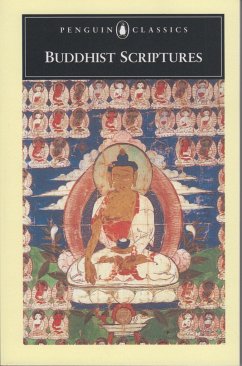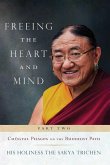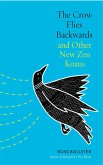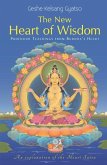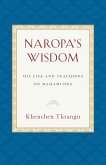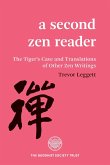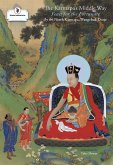Schade – dieser Artikel ist leider ausverkauft. Sobald wir wissen, ob und wann der Artikel wieder verfügbar ist, informieren wir Sie an dieser Stelle.
- Broschiertes Buch
- Merkliste
- Auf die Merkliste
- Bewerten Bewerten
- Teilen
- Produkt teilen
- Produkterinnerung
- Produkterinnerung
A volume of key writings on the Buddha, collected from a variety of languages and traditions While Buddhism has no central text comparable to the Bible or Koran, there is a powerful body of scripture from across Asia that encompasses the dharma, or the teachings of the Buddha. In this rich anthology, eminent scholar Donald S. Lopez, Jr. brings together works from a broad historical and geographical range, and from such languages as Pali, Sanskrit, Tibetan, Chinese, and Japanese. There are tales of the Buddha's past lives, a discussion of qualities and qualifications for a monk, and an…mehr
Andere Kunden interessierten sich auch für
![Freeing the Heart and Mind Freeing the Heart and Mind]() His Holiness Sakya TrichenFreeing the Heart and Mind14,99 €
His Holiness Sakya TrichenFreeing the Heart and Mind14,99 €![The Crow Flies Backwards and Other New Zen Koans The Crow Flies Backwards and Other New Zen Koans]() Ross BolleterThe Crow Flies Backwards and Other New Zen Koans15,99 €
Ross BolleterThe Crow Flies Backwards and Other New Zen Koans15,99 €![The New Heart of Wisdom The New Heart of Wisdom]() Geshe Kelsang GyatsoThe New Heart of Wisdom21,99 €
Geshe Kelsang GyatsoThe New Heart of Wisdom21,99 €![Naropa's Wisdom: His Life and Teachings on Mahamudra Naropa's Wisdom: His Life and Teachings on Mahamudra]() Khenchen ThranguNaropa's Wisdom: His Life and Teachings on Mahamudra17,99 €
Khenchen ThranguNaropa's Wisdom: His Life and Teachings on Mahamudra17,99 €![A Second Zen Reader: The Tiger's Cave and Translations of Other Zen Writings A Second Zen Reader: The Tiger's Cave and Translations of Other Zen Writings]() A Second Zen Reader: The Tiger's Cave and Translations of Other Zen Writings14,99 €
A Second Zen Reader: The Tiger's Cave and Translations of Other Zen Writings14,99 €![The Karmapa's Middle Way The Karmapa's Middle Way]() Wangchuk DorjeThe Karmapa's Middle Way35,99 €
Wangchuk DorjeThe Karmapa's Middle Way35,99 €![Yoka Daishi's Realizing the Way: Translation and Commentary Yoka Daishi's Realizing the Way: Translation and Commentary]() Yoka DaishiYoka Daishi's Realizing the Way: Translation and Commentary15,99 €
Yoka DaishiYoka Daishi's Realizing the Way: Translation and Commentary15,99 €
A volume of key writings on the Buddha, collected from a variety of languages and traditions While Buddhism has no central text comparable to the Bible or Koran, there is a powerful body of scripture from across Asia that encompasses the dharma, or the teachings of the Buddha. In this rich anthology, eminent scholar Donald S. Lopez, Jr. brings together works from a broad historical and geographical range, and from such languages as Pali, Sanskrit, Tibetan, Chinese, and Japanese. There are tales of the Buddha's past lives, a discussion of qualities and qualifications for a monk, and an exploration of the many meanings of enlightenment. Together they provide a vivid picture of the Buddha and of the vast and profound nature of the Buddhist tradition. For more than seventy years, Penguin has been the leading publisher of classic literature in the English-speaking world. With more than 1,700 titles, Penguin Classics represents a global bookshelf of the best works throughout history and across genres and disciplines. Readers trust the series to provide authoritative texts enhanced by introductions and notes by distinguished scholars and contemporary authors, as well as up-to-date translations by award-winning translators.
Produktdetails
- Produktdetails
- Verlag: Penguin Publishing Group
- Seitenzahl: 256
- Erscheinungstermin: 30. Juli 1959
- Englisch
- Abmessung: 198mm x 130mm x 15mm
- Gewicht: 186g
- ISBN-13: 9780140440881
- ISBN-10: 0140440887
- Artikelnr.: 21882269
- Herstellerkennzeichnung
- Libri GmbH
- Europaallee 1
- 36244 Bad Hersfeld
- gpsr@libri.de
- Verlag: Penguin Publishing Group
- Seitenzahl: 256
- Erscheinungstermin: 30. Juli 1959
- Englisch
- Abmessung: 198mm x 130mm x 15mm
- Gewicht: 186g
- ISBN-13: 9780140440881
- ISBN-10: 0140440887
- Artikelnr.: 21882269
- Herstellerkennzeichnung
- Libri GmbH
- Europaallee 1
- 36244 Bad Hersfeld
- gpsr@libri.de
Anonymous; Translated by Edward Conze
Buddhist ScripturesAcknowledgments
Introduction
PART I: THE TEACHER
Chapter 1. The Buddha's Previous Lives
Introductory Note
1. Shakyamuni's Meeting with Dipankara
2a. The Bodhisattva and the Hungry Tigress
2b. The Bodhisattva as the Preacher of Patience
3. Outline of a Bodhisattva's Progress
Chapter 2. The Legend of the Buddha Shakyamuni
Introductory Note
1. The birth of the Bodhisattva
2. Asita's visit
3. The Bodhisattva's youth and marriage
4. The awakening
5. Withdrawal from the women
6. The flight
7. The apparition of a mendicant
8. The dismissal of Chandaka
9. The practice of austerities
10. Nandabala's gift
11. The defeat of Mara
12. The Enlightenment
13. The meeting with the mendicant
14. The meeting with the five mendicants
15. Turning the wheel of Dharma
16. The meeting of father and son
17. Further conversions
18. Devadatta
19. The desire for death
20. The leave-taking from Vaisali, the final couch, instructions to the
Mallas
21. Parinirvana
22. The Relics
23. The Scriptures
PART II: DOCTRINES
Chapter 1. Morality
Introductory Note
1. The Five Precepts, with Buddahghosa's commentary
2. Rules of monastric restraint
3. The monk's life
3a. The Buddha's advice to Sariputra (E.M.H.)
3b. The Rhinoceros (E.M.H.)
4. Verses from the Sanskrit Dharmapada
4a. The chapter on Karma
4b. The chapter on Morality
5. Popular Moral Buddhism
6. Laymen and Monks
6a. Their respective attainments
6b. Their respective tasks, and the question of the adoration of relics
Chapter 2. Meditation
Introductory Note
1. The advantages of meditation
2. The practice of introversion
3. The progressive steps of meditation
The restraint of the senses - How the senses cause bondage - Moderation in
eating - The avoidance of sleep - Full awareness of the postures, etc. -
The advantages of solitary meditation - Concentration and the forsaking of
idle thoughts - How to deal with thoughts concerning family and homeland -
How to be mindful of death - The four holy truths
4. The six types of persons
5. The five miraculous powers
6. Zen
6a. Sessan Amakuki. Zen Meditation (R.T.L.)
6b. Rosen Takashina. Controlling the Mind (R.T.L.)
Chapter 3. Wisdom
Introductory Note
1. The Questions of King Milinda
1. Introduction - 2. The doctrine of not-self: (a) The chariot, (b)
Personal identity and rebirth, (c) personal identity and Karma - 3. The
five cardinal virtues - 4. Emancipation and Nirvana: (a) Problems of
Nirvana, (b) The nature of Nirvana, (c) The realization of Nirvana, (d) The
saints and their bodies - 5. Conclusion
2. The Heart Sutra
3. From the "Diamond Sutra"
The Bodhisattva and Dipankara - The initial vow of a Bodhisattva - The
practice of perfect giving - The practice of perfect patience - The
Bodhisattva's final Nirvana - The Bodhisattva as a fully enlightened Buddha
- The Buddha's physical body - The Buddha as the Tathagata - The Buddha as
a Teacher - The Buddha as a Saviour - The application to the present day
4. Rabulabhadra. "Hymn to Perfect Wisdom"
5. Sent-ts'an. "On Believing in Mind" (D.T.S.)
6. From Saraba's "Treasury of Songs" (D.L.S.)
Chapter 4. Doctrinal Formulas
Introductory Note
1. Faith: The Triple Refuge - The Buddha - The Dharma - The Samgha
2. Vigour: The four right efforts - The Bodhisattva's Vow
3. Mindfulness: On guarding the senses
4. Concentration: The four trances - The four formless trances - The four
Unlimited - Unlimited Friendliness
5. Wisdom: The four Holy Truths - Conditioned co-production - The view of
self - The absence of self in everything - The illusory nature of the world
Chapter 5. Doctrinal Disputes
Introductory Note
1. The Personalist Controversy
2. Mahayana Polemics against the Hinayana
3. Can there be more than one Buddha at a time?
3a. The Hinayana position
3b. The Mahayana position
4. The Quietist Controversy
PART III: OTHER WORLDS AND FUTURE TIMES
Chapter 1. Other Worlds
Introductory Note
1. The bliss of the heavens
2. The torments of the bells
3. Life after death, and the "Book of the Dead"
Preamble - I. The moment of death, and the clear light of Pure Reality. The
emergence of a subtle body. - II. The experience of the spiritual realities
- III. Seeking rebirth. The judgement. The desire for rebirth. The dawning
of the lights of the six places of rebirth. Re-incarnation.
4. Celestial Paradises: The Pure Land of Amitabha
Chapter 2. Maitreya, the future Buddha
Introductory Note
"The Prophecy concerning Maitreya"
Sources
Glossary of Technical Terms
Introduction
PART I: THE TEACHER
Chapter 1. The Buddha's Previous Lives
Introductory Note
1. Shakyamuni's Meeting with Dipankara
2a. The Bodhisattva and the Hungry Tigress
2b. The Bodhisattva as the Preacher of Patience
3. Outline of a Bodhisattva's Progress
Chapter 2. The Legend of the Buddha Shakyamuni
Introductory Note
1. The birth of the Bodhisattva
2. Asita's visit
3. The Bodhisattva's youth and marriage
4. The awakening
5. Withdrawal from the women
6. The flight
7. The apparition of a mendicant
8. The dismissal of Chandaka
9. The practice of austerities
10. Nandabala's gift
11. The defeat of Mara
12. The Enlightenment
13. The meeting with the mendicant
14. The meeting with the five mendicants
15. Turning the wheel of Dharma
16. The meeting of father and son
17. Further conversions
18. Devadatta
19. The desire for death
20. The leave-taking from Vaisali, the final couch, instructions to the
Mallas
21. Parinirvana
22. The Relics
23. The Scriptures
PART II: DOCTRINES
Chapter 1. Morality
Introductory Note
1. The Five Precepts, with Buddahghosa's commentary
2. Rules of monastric restraint
3. The monk's life
3a. The Buddha's advice to Sariputra (E.M.H.)
3b. The Rhinoceros (E.M.H.)
4. Verses from the Sanskrit Dharmapada
4a. The chapter on Karma
4b. The chapter on Morality
5. Popular Moral Buddhism
6. Laymen and Monks
6a. Their respective attainments
6b. Their respective tasks, and the question of the adoration of relics
Chapter 2. Meditation
Introductory Note
1. The advantages of meditation
2. The practice of introversion
3. The progressive steps of meditation
The restraint of the senses - How the senses cause bondage - Moderation in
eating - The avoidance of sleep - Full awareness of the postures, etc. -
The advantages of solitary meditation - Concentration and the forsaking of
idle thoughts - How to deal with thoughts concerning family and homeland -
How to be mindful of death - The four holy truths
4. The six types of persons
5. The five miraculous powers
6. Zen
6a. Sessan Amakuki. Zen Meditation (R.T.L.)
6b. Rosen Takashina. Controlling the Mind (R.T.L.)
Chapter 3. Wisdom
Introductory Note
1. The Questions of King Milinda
1. Introduction - 2. The doctrine of not-self: (a) The chariot, (b)
Personal identity and rebirth, (c) personal identity and Karma - 3. The
five cardinal virtues - 4. Emancipation and Nirvana: (a) Problems of
Nirvana, (b) The nature of Nirvana, (c) The realization of Nirvana, (d) The
saints and their bodies - 5. Conclusion
2. The Heart Sutra
3. From the "Diamond Sutra"
The Bodhisattva and Dipankara - The initial vow of a Bodhisattva - The
practice of perfect giving - The practice of perfect patience - The
Bodhisattva's final Nirvana - The Bodhisattva as a fully enlightened Buddha
- The Buddha's physical body - The Buddha as the Tathagata - The Buddha as
a Teacher - The Buddha as a Saviour - The application to the present day
4. Rabulabhadra. "Hymn to Perfect Wisdom"
5. Sent-ts'an. "On Believing in Mind" (D.T.S.)
6. From Saraba's "Treasury of Songs" (D.L.S.)
Chapter 4. Doctrinal Formulas
Introductory Note
1. Faith: The Triple Refuge - The Buddha - The Dharma - The Samgha
2. Vigour: The four right efforts - The Bodhisattva's Vow
3. Mindfulness: On guarding the senses
4. Concentration: The four trances - The four formless trances - The four
Unlimited - Unlimited Friendliness
5. Wisdom: The four Holy Truths - Conditioned co-production - The view of
self - The absence of self in everything - The illusory nature of the world
Chapter 5. Doctrinal Disputes
Introductory Note
1. The Personalist Controversy
2. Mahayana Polemics against the Hinayana
3. Can there be more than one Buddha at a time?
3a. The Hinayana position
3b. The Mahayana position
4. The Quietist Controversy
PART III: OTHER WORLDS AND FUTURE TIMES
Chapter 1. Other Worlds
Introductory Note
1. The bliss of the heavens
2. The torments of the bells
3. Life after death, and the "Book of the Dead"
Preamble - I. The moment of death, and the clear light of Pure Reality. The
emergence of a subtle body. - II. The experience of the spiritual realities
- III. Seeking rebirth. The judgement. The desire for rebirth. The dawning
of the lights of the six places of rebirth. Re-incarnation.
4. Celestial Paradises: The Pure Land of Amitabha
Chapter 2. Maitreya, the future Buddha
Introductory Note
"The Prophecy concerning Maitreya"
Sources
Glossary of Technical Terms
Buddhist ScripturesAcknowledgments
Introduction
PART I: THE TEACHER
Chapter 1. The Buddha's Previous Lives
Introductory Note
1. Shakyamuni's Meeting with Dipankara
2a. The Bodhisattva and the Hungry Tigress
2b. The Bodhisattva as the Preacher of Patience
3. Outline of a Bodhisattva's Progress
Chapter 2. The Legend of the Buddha Shakyamuni
Introductory Note
1. The birth of the Bodhisattva
2. Asita's visit
3. The Bodhisattva's youth and marriage
4. The awakening
5. Withdrawal from the women
6. The flight
7. The apparition of a mendicant
8. The dismissal of Chandaka
9. The practice of austerities
10. Nandabala's gift
11. The defeat of Mara
12. The Enlightenment
13. The meeting with the mendicant
14. The meeting with the five mendicants
15. Turning the wheel of Dharma
16. The meeting of father and son
17. Further conversions
18. Devadatta
19. The desire for death
20. The leave-taking from Vaisali, the final couch, instructions to the
Mallas
21. Parinirvana
22. The Relics
23. The Scriptures
PART II: DOCTRINES
Chapter 1. Morality
Introductory Note
1. The Five Precepts, with Buddahghosa's commentary
2. Rules of monastric restraint
3. The monk's life
3a. The Buddha's advice to Sariputra (E.M.H.)
3b. The Rhinoceros (E.M.H.)
4. Verses from the Sanskrit Dharmapada
4a. The chapter on Karma
4b. The chapter on Morality
5. Popular Moral Buddhism
6. Laymen and Monks
6a. Their respective attainments
6b. Their respective tasks, and the question of the adoration of relics
Chapter 2. Meditation
Introductory Note
1. The advantages of meditation
2. The practice of introversion
3. The progressive steps of meditation
The restraint of the senses - How the senses cause bondage - Moderation in
eating - The avoidance of sleep - Full awareness of the postures, etc. -
The advantages of solitary meditation - Concentration and the forsaking of
idle thoughts - How to deal with thoughts concerning family and homeland -
How to be mindful of death - The four holy truths
4. The six types of persons
5. The five miraculous powers
6. Zen
6a. Sessan Amakuki. Zen Meditation (R.T.L.)
6b. Rosen Takashina. Controlling the Mind (R.T.L.)
Chapter 3. Wisdom
Introductory Note
1. The Questions of King Milinda
1. Introduction - 2. The doctrine of not-self: (a) The chariot, (b)
Personal identity and rebirth, (c) personal identity and Karma - 3. The
five cardinal virtues - 4. Emancipation and Nirvana: (a) Problems of
Nirvana, (b) The nature of Nirvana, (c) The realization of Nirvana, (d) The
saints and their bodies - 5. Conclusion
2. The Heart Sutra
3. From the "Diamond Sutra"
The Bodhisattva and Dipankara - The initial vow of a Bodhisattva - The
practice of perfect giving - The practice of perfect patience - The
Bodhisattva's final Nirvana - The Bodhisattva as a fully enlightened Buddha
- The Buddha's physical body - The Buddha as the Tathagata - The Buddha as
a Teacher - The Buddha as a Saviour - The application to the present day
4. Rabulabhadra. "Hymn to Perfect Wisdom"
5. Sent-ts'an. "On Believing in Mind" (D.T.S.)
6. From Saraba's "Treasury of Songs" (D.L.S.)
Chapter 4. Doctrinal Formulas
Introductory Note
1. Faith: The Triple Refuge - The Buddha - The Dharma - The Samgha
2. Vigour: The four right efforts - The Bodhisattva's Vow
3. Mindfulness: On guarding the senses
4. Concentration: The four trances - The four formless trances - The four
Unlimited - Unlimited Friendliness
5. Wisdom: The four Holy Truths - Conditioned co-production - The view of
self - The absence of self in everything - The illusory nature of the world
Chapter 5. Doctrinal Disputes
Introductory Note
1. The Personalist Controversy
2. Mahayana Polemics against the Hinayana
3. Can there be more than one Buddha at a time?
3a. The Hinayana position
3b. The Mahayana position
4. The Quietist Controversy
PART III: OTHER WORLDS AND FUTURE TIMES
Chapter 1. Other Worlds
Introductory Note
1. The bliss of the heavens
2. The torments of the bells
3. Life after death, and the "Book of the Dead"
Preamble - I. The moment of death, and the clear light of Pure Reality. The
emergence of a subtle body. - II. The experience of the spiritual realities
- III. Seeking rebirth. The judgement. The desire for rebirth. The dawning
of the lights of the six places of rebirth. Re-incarnation.
4. Celestial Paradises: The Pure Land of Amitabha
Chapter 2. Maitreya, the future Buddha
Introductory Note
"The Prophecy concerning Maitreya"
Sources
Glossary of Technical Terms
Introduction
PART I: THE TEACHER
Chapter 1. The Buddha's Previous Lives
Introductory Note
1. Shakyamuni's Meeting with Dipankara
2a. The Bodhisattva and the Hungry Tigress
2b. The Bodhisattva as the Preacher of Patience
3. Outline of a Bodhisattva's Progress
Chapter 2. The Legend of the Buddha Shakyamuni
Introductory Note
1. The birth of the Bodhisattva
2. Asita's visit
3. The Bodhisattva's youth and marriage
4. The awakening
5. Withdrawal from the women
6. The flight
7. The apparition of a mendicant
8. The dismissal of Chandaka
9. The practice of austerities
10. Nandabala's gift
11. The defeat of Mara
12. The Enlightenment
13. The meeting with the mendicant
14. The meeting with the five mendicants
15. Turning the wheel of Dharma
16. The meeting of father and son
17. Further conversions
18. Devadatta
19. The desire for death
20. The leave-taking from Vaisali, the final couch, instructions to the
Mallas
21. Parinirvana
22. The Relics
23. The Scriptures
PART II: DOCTRINES
Chapter 1. Morality
Introductory Note
1. The Five Precepts, with Buddahghosa's commentary
2. Rules of monastric restraint
3. The monk's life
3a. The Buddha's advice to Sariputra (E.M.H.)
3b. The Rhinoceros (E.M.H.)
4. Verses from the Sanskrit Dharmapada
4a. The chapter on Karma
4b. The chapter on Morality
5. Popular Moral Buddhism
6. Laymen and Monks
6a. Their respective attainments
6b. Their respective tasks, and the question of the adoration of relics
Chapter 2. Meditation
Introductory Note
1. The advantages of meditation
2. The practice of introversion
3. The progressive steps of meditation
The restraint of the senses - How the senses cause bondage - Moderation in
eating - The avoidance of sleep - Full awareness of the postures, etc. -
The advantages of solitary meditation - Concentration and the forsaking of
idle thoughts - How to deal with thoughts concerning family and homeland -
How to be mindful of death - The four holy truths
4. The six types of persons
5. The five miraculous powers
6. Zen
6a. Sessan Amakuki. Zen Meditation (R.T.L.)
6b. Rosen Takashina. Controlling the Mind (R.T.L.)
Chapter 3. Wisdom
Introductory Note
1. The Questions of King Milinda
1. Introduction - 2. The doctrine of not-self: (a) The chariot, (b)
Personal identity and rebirth, (c) personal identity and Karma - 3. The
five cardinal virtues - 4. Emancipation and Nirvana: (a) Problems of
Nirvana, (b) The nature of Nirvana, (c) The realization of Nirvana, (d) The
saints and their bodies - 5. Conclusion
2. The Heart Sutra
3. From the "Diamond Sutra"
The Bodhisattva and Dipankara - The initial vow of a Bodhisattva - The
practice of perfect giving - The practice of perfect patience - The
Bodhisattva's final Nirvana - The Bodhisattva as a fully enlightened Buddha
- The Buddha's physical body - The Buddha as the Tathagata - The Buddha as
a Teacher - The Buddha as a Saviour - The application to the present day
4. Rabulabhadra. "Hymn to Perfect Wisdom"
5. Sent-ts'an. "On Believing in Mind" (D.T.S.)
6. From Saraba's "Treasury of Songs" (D.L.S.)
Chapter 4. Doctrinal Formulas
Introductory Note
1. Faith: The Triple Refuge - The Buddha - The Dharma - The Samgha
2. Vigour: The four right efforts - The Bodhisattva's Vow
3. Mindfulness: On guarding the senses
4. Concentration: The four trances - The four formless trances - The four
Unlimited - Unlimited Friendliness
5. Wisdom: The four Holy Truths - Conditioned co-production - The view of
self - The absence of self in everything - The illusory nature of the world
Chapter 5. Doctrinal Disputes
Introductory Note
1. The Personalist Controversy
2. Mahayana Polemics against the Hinayana
3. Can there be more than one Buddha at a time?
3a. The Hinayana position
3b. The Mahayana position
4. The Quietist Controversy
PART III: OTHER WORLDS AND FUTURE TIMES
Chapter 1. Other Worlds
Introductory Note
1. The bliss of the heavens
2. The torments of the bells
3. Life after death, and the "Book of the Dead"
Preamble - I. The moment of death, and the clear light of Pure Reality. The
emergence of a subtle body. - II. The experience of the spiritual realities
- III. Seeking rebirth. The judgement. The desire for rebirth. The dawning
of the lights of the six places of rebirth. Re-incarnation.
4. Celestial Paradises: The Pure Land of Amitabha
Chapter 2. Maitreya, the future Buddha
Introductory Note
"The Prophecy concerning Maitreya"
Sources
Glossary of Technical Terms

